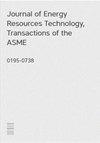Effect of Outlet Shape on Flame Height of Transformer Oil Jet Fire under External Fire Source
IF 2.4
3区 工程技术
Q3 ENERGY & FUELS
Journal of Energy Resources Technology-transactions of The Asme
Pub Date : 2023-10-18
DOI:10.1115/1.4063841
引用次数: 0
Abstract
Abstract In this inquiry, we delve into the manner by which disparate orifice configurations exert influence upon the elevation of the jet flame when subjected to an external conflagration, employing empirical simulations. Elaborating upon the empirical dataset, we introduce the derivative of hydraulic diameter alterations and the velocity of material degradation, thereby revising the traditional non-dimensionalized model of flame altitude. The revelations disclose that, across an array of orifice profiles, the conflagration jet within oil-laden apparatus undergoes four discernible phases of evolution, each replete with variable flambeau altitudes. In disparate operational circumstances, the quantified velocity of material degradation during the evolution phase manifests an exponential interrelation with the approximated value of the model. Conversely, the phases of stability and decline adhere to a potency function connection. A quantitative delineation of the pivotal states for each phase of combustion is achieved through the evaluation of the rate of alteration in the velocity of material degradation. Significantly, the pivotal juncture for the proliferation and equilibrium stage is ascertained to be 2 g/s. This scientific inquiry confers invaluable theoretical reinforcement for fire safeguarding and catastrophe evaluation within substations accommodating oil-infused apparatus.外火源下变压器油射流火焰出口形状对火焰高度的影响
摘要:在本次调查中,我们深入研究了不同的孔配置施加对射流火焰的高度影响的方式,当受到外部燃烧时,采用经验模拟。在经验数据集的基础上,引入水力直径变化和材料退化速度的导数,从而修正了传统的火焰高度无量纲化模型。这些披露表明,在一系列的孔口剖面上,装有石油的装置内的火焰射流经历了四个可识别的进化阶段,每个阶段都充满了可变的火焰高度。在不同的操作环境下,演化阶段材料降解的量化速度与模型的近似值呈指数关系。相反,稳定和衰退的阶段坚持一个效力函数连接。通过评估材料降解速度的变化率,可以定量地描绘出燃烧的每个阶段的关键状态。值得注意的是,扩散和平衡阶段的关键时刻被确定为2g /s。这一科学研究为安装注油设备的变电站的防火和灾害评估提供了宝贵的理论支持。
本文章由计算机程序翻译,如有差异,请以英文原文为准。
求助全文
约1分钟内获得全文
求助全文
来源期刊
CiteScore
6.40
自引率
30.00%
发文量
213
审稿时长
4.5 months
期刊介绍:
Specific areas of importance including, but not limited to: Fundamentals of thermodynamics such as energy, entropy and exergy, laws of thermodynamics; Thermoeconomics; Alternative and renewable energy sources; Internal combustion engines; (Geo) thermal energy storage and conversion systems; Fundamental combustion of fuels; Energy resource recovery from biomass and solid wastes; Carbon capture; Land and offshore wells drilling; Production and reservoir engineering;, Economics of energy resource exploitation

 求助内容:
求助内容: 应助结果提醒方式:
应助结果提醒方式:


